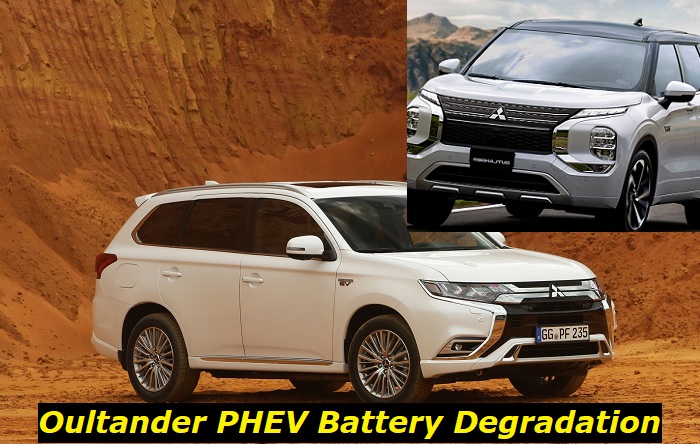The Outlander PHEV has proved to be one of the best hybrid SUVs on the market. It appeared quite long ago, in 2013, to be precise. And how it has a lot of reviews to analyze and decide if it's actually a good vehicle to buy. Before we start, we want to say that we love this vehicle for its outstanding gas mileage and great comfort. But we also have some reasons to hate it.
Battery lifespan highlights
- Average lifespan:4-5 years for 12V,10years for Li-Ion
- Average price:$150 - $250 for 12V, $1,000-$4,500 for Li-Ion
- Reasons for death:deep discharge, constant drains, age
- Prevention:regular charging, good contacts
- Ways to fix:charging, replacement
- DIY repairs:possible

New and old Outlander PHEV - any difference?
The PHEV or plug-in hybrid version of the Mitsubishi Outlander was first shown in 2013 together with the third generation of the SUV. It was a saving technology for the company because worldwide sales started going down. And it worked, people were interested in an SUV that could deliver 74 mpg in the city.
In 2022, the company offered the next generation of the Outlander, and now PHEV became one of the main versions in the marketing strategy of the company. Of course, now the vehicle needs to compete with many more other hybrid models than back in 2013. But the Outlander has its name and rating.
Here's what you should know about this vehicle:
- in the older version, PHEV technology was used with two engines - 2.0 and 2.4 MIVEC engines that actually differ only in displacement in power sharing the same technologies;
- in the newer generation, the 2.4-liter engine is the only option for the PHEV version of the SUV;
- the hybrid technology offers two electric motors - one front and one rear - and also a gasoline-powered motor to charge them on the go and to help them move the vehicle;
- the PHEV vehicle is notorious for the option of plug-in charging, so you can use it as an electric vehicle without burning any gas at all;
- in electric-only mode, the new-gen Outlander PHEV can go about 54 miles, after that the gas motor kicks in or you need to charge the battery;
- of course, the vehicle can easily drive without using electric motors, relying only on the gas engine under its hood.
This is a really good and decent hybrid SUV that is going to save you money. These cars are perfect for those who travel up to 50 miles a day - you can just use your Outlander as an EV and avoid worrying about a possible low charge or flat battery because your gasoline engine may always back you up.
If you drive on the highway, electric motors don't work much. In this way, your Outlander PHEV turns into a simple Outlander with a 2.4-liter gas-powered engine which is not bad at all. The only thing - the fuel consumption will be higher on the highway than in the city.
How long will the battery live in your Outlander PHEV?
The battery lifespan is one of the central questions you should ask before buying an EV or a hybrid. That's because replacing a battery in such a vehicle is a disaster for your budget. Want to spend a couple of grands just for a new battery setup? You may buy an Outlander PHEV without checking its condition and you are guaranteed to have this problem.
So, battery degradation is very important to know. And with the Outlander PHEV, we should say that Mitsubishi offers a special battery warranty of 8 years of 100,000 miles in some markets. It means that the company is sure whatever happens with the battery, it will survive that long.
And still, the average lifespan of a battery in a hybrid vehicle is about 10 years and the Outlander is not an exception to this rule. So, if you are about to buy a 2013 Mitsubishi Outlander hybrid, you should be very careful with your checkups and the final decision. Maybe, it's not the best option you can find on the market.
Age is an important factor for a battery. We know some Outlander owners who started getting first problems with the battery after just 5 years of using their vehicles and with low mileage.
Also, mileage is important. We doubt if the battery in the Outlander hybrid SUV may last longer than 200,000 miles. Even if you drive those miles for 4 years, the battery will probably die.
So, after reading owners' reviews and talking to anonymous mechanics at two Mitsubishi dealerships, we concluded that the Outlander PHEV batteries live on average 8 years or 150,000 miles. After one of these milestones comes, the vehicle starts throwing problems at its owner and the owner needs to throw money back at his vehicle to deal with those problems.
How much is it to replace a battery in the Mitsubishi Outlander PHEV?
The older Outlander offered a 12-kWh battery that consisted of 5 modules. But the newer version presented in 2022 offers a 20-kWh battery. The third-gen Outlander PHEV was much cheaper to repair: one new module of the battery costs about $500 on the market of used parts with no wear and about $900 for a new module. The whole battery assembly will cost $5K if you buy it from a dealer but you can find cheaper options out there.
The new-generation Outlander PHEV offers a better range and more gas economy but the battery is of higher capacity, hence it costs more. We believe a dealer will ask you to pay about $12,000 for the whole battery assembly. The good news is you can still buy a separate module and replace it to partially renew the battery and make it go longer.
The labor costs won't be very high because replacing this battery is not a really hard task. We know a guy who even did it by himself spending about 7 hours in his garage. But we would opt for a dealer or a shop because if it's your fault, you will pay for dealing with the consequences.
So, the whole battery replacement in your Outlander PHEV will cost you more than $5K for the older vehicle and over $12K for the fourth-generation Mitsubishi.
How can you make the battery live longer?
Now, when you already know that replacing a battery in your PHEV SUV is not an affordable process, you should worry more about the lifespan of the part and do everything to prolong its life up until you decide to change your vehicle to a new one.
It takes some effort to save your battery's life because some of the recommendations are too hard to follow in everyday life. And we totally understand that 90% of owners will not care about it. But still, you asked us about prolonging the battery life and we are answering.
Here's what you should do:
- always recharge your battery in the Outlander PHEV once the charge is less than 15%;
- never charge it from a plug-in charging for more than 80%, you will save the battery this way;
- try to use electric-only mode most of the time you are driving in the city;
- look at the dashboard messages and always follow the tips your vehicle gives you;
- once the battery degradation is obvious, find a specialist who can replace one of the modules;
- regularly have the battery tested and checked when the cat is going through regular maintenance;
- don't drive your vehicle on the highway using electric-only mode;
- don't use fast-charging stations, better use your home grid to charge the Outlander.
We can add that extremely high or low temperatures are both very bad for the battery life. But we can't come up with the idea of what you can change to avoid this. The tip "relocate to another state to avoid temperature degradation of the battery" would sound too weird, right?
Unfortunately, even if you follow all tips, the Outlander PHEV battery will live about 200,000 miles or even less.
Final words
You should understand that owning a PHEV vehicle allows you to economize some money at gas pumps. But you should also know that these hybrid cars are expensive to maintain and repair. The battery is one of the most expensive modules in your Mitsubishi Outlander PHEV vehicle and it can go bad as soon as after 100,000 miles if used carelessly.
Replacing the whole battery is pretty expensive, so you can come up with a partial replacement of the modules to make the battery live longer.
About the authors
The CarAraC research team is composed of seasoned auto mechanics and automotive industry professionals, including individuals with advanced degrees and certifications in their field. Our team members boast prestigious credentials, reflecting their extensive knowledge and skills. These qualifications include: IMI: Institute of the Motor Industry, ASE-Certified Master Automobile Technicians; Coventry University, Graduate of MA in Automotive Journalism; Politecnico di Torino, Italy, MS Automotive Engineering; Ss. Cyril and Methodius University in Skopje, Mechanical University in Skopje; TOC Automotive College; DHA Suffa University, Department of Mechanical Engineering






Add comment